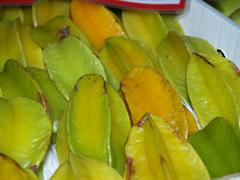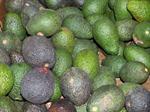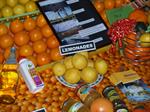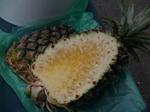
Become an expert in growing tropical fruits
-growing in warm climates or in protected places such as a greenhouse.
- Learn to establish & manage commercial fruit production for warm climates.
- Discover the huge variety of fruits that are grown in warm climates (hundreds)
- Explore how many can be adapted to cooler climates -if nothing else, as container or greenhouse plants
- As an amateur, follow a passion
- As a professional -extend your plant skills
This is a course for the hobby farmer or home owner striving for self sufficiency, through to the commercial fruit farmer or their staff.
Lesson Structure:
There are 8 lessons in this course:
1. Introduction To Warm Climate Fruit Growing
-
Deciding what to grow
-
Where to get helpful information and start networking
-
Scope of Warm Fruit Growing -Review of main groups: Citrus, Berries, Nuts, Vines, Other fruits.
-
Understanding plant naming
-
Review of tropical fruit families:Anacardiaceae, Annonaceae, Apocynaceae, Bombaceae, Bursaraceae, Ebenaceae, Euphorbiaceae, Fabaceae, Flacourtiaceae, Guttiferae, Lauraceae, Lecythidaceae, Malpighiaceae, Meliaceae, Moraceae, Musaceae, Myrtaceae, Oxalidaceae, Palmae, Pasifloraceae, Proteaceae, Rhamnaceae,Rubiaceae,Rutaceae, Sapindaceae.
-
The botany of a fruit
-
Types of Fruits
2. Establishing An Orchard
- Develop a plan for the establishment of an orchard
- Site considerations -choosing a site
- Understanding Soils and Nutrition
- Soil Testing
- Several warm climate fruits are then reviewed including: Avocado Banana, Citrus, Cocao, Coffee, Macadamia and Paw Paw
3. General Cultural Practices
- Fertilsers and Nutrition
- Pest and Disease -determining and managing problems
- What problems occur on what fruit plants
- Weed control
- Frost and sun protection
- Drainage
- Pruning
4. Tree Fruits
- Avocado

- Banana
- Star Fruit (Carambola)
- Custard Apple
- Durian
- Jackfruit
- Lychee
- Mango
- Mangosteen
- Rambutan
- Sapodila
- White Sapote
- Paw Paw
5. Nuts, Vines and Berries
- Strawberry
- Solanum
- Pepino
- Tamarillo
- Lilly Pilly
- Passionfruit
- Coconut
- Macadamia
- Peanut
- Pecan
- Pistacio
- Cashew
- Brazil Nut
6. Citrus and other Fruits
- Suitability to different climates
- Grapefruit
- Mandarin
- Tangelo
- Sweet Orange
- Meyer Lemon and other Lemons
- Limes
- Figs
- Olives
- Guava
- Pineapple
- Pomegranate, Persimmon, Quandong etc.
7. Cultural Management Of A Fruit Plantation or Orchard
8. Marketing Your Produce
- Considering marketing options
- Market Research
- Maintaining marketing standards and selling
Aims:
- Identify different types of fruit crops, which can be successfully grown in a specific region.
- Explain the nature of the fruit industry in a specific region.
- Determine the cultural requirements for different fruit crops.
- Develop a plan for the establishment of an orchard.
- Formulate appropriate methods for marketing specific fruit crops grown in your locality.
- Develop a calendar for cultural management of a fruit plantation, or orchard.
 WHAT CAN BE GROWN IN THE TROPICS AND SUB TROPICS?
WHAT CAN BE GROWN IN THE TROPICS AND SUB TROPICS?
Citrus
Requires a large area, takes at least 3 years from planting to production of any worthwhile crop, full production takes a lot longer; trees can remain productive for a hundred years or more. Many orchards were uprooted in the late '60's and early 70's when supply exceeded demand. Since then there has been a boom in citrus processing (packaged orange juice etc) and demand has increased significantly. Another development in the past decade has been a steady trend towards mechanisation in the citrus industry. You may consider lack of finance a serious limitation to efficient production of citrus. This might be something you need to plan for in the future to be competitive.
Citrus fruit keep and transport well. Products include fresh fruit, juice, marmalade, rind/peel, and some canned and candied fruits. Small areas of ½ acre or so have been a productive unit in the past.
Berry fruits
Highly productive for the area cultivated. A couple of acres of berries can support a small family. Tree fruits may require 20 acres or more to bring a similar return. The world’s most popular berry, the strawberry; can be grown in both warm climates and temperate climates. Others, including brambles, raspberries, blueberries and currants are far less suited to warm climates.
A range of other “tropical” berries are grown for edible fruit in some parts of the world; including: some types of Lilly Pilly (Syzygium spp. And Eugenia spp.), Panama Berry (Muntingia calabura), some of Solanum species, Miracle Fruit (Synsepalum dulcificum), Jaboticaba (Myrciaria cauliflora), Wampi (Clausena lansium)
Some berries last only a few seasons (eg: strawberries). Most of the berries fruits are soft and do not keep fresh for very long. Products may include: fresh fruit, jams, syrups and some frozen fruit.
Nuts
Most require a relatively large area to produce a worthwhile crop. Most nuts grow on trees and take at least 4 years from planting to the time when significant crops are produced (some 10 years or more). Keeping qualities are good if kept dry. You will require at least a couple of acres to produce marketable quantities.
Nuts which are widely grown warm climate nuts include Peanut, Cashew, Macadamia and Coconut (though Coconut and Peanut are not strictly always considered a nut).
Vines
A range of passionfruits are grown widely in tropical and sub-tropical areas around the world. Other vines sometimes grown in warm climates include Chinese Gooseberry and Grape. Even though they are not traditionally considered a tropical plant, grapes are increasingly being grown in warmer climates. Cultural methods may be a little different at times and variety selection can be important.
Grapes require a medium to large area (more than berries but not as much as nuts or citrus). Most of the world’s crop is dried or used for wine, but fruits are also dried, juiced and eaten fresh.
Growing for drying is only worthwhile in low rainfall areas. Growing for wine can be profitable in a wide range of areas (high to low rainfall). Dried fruit or wine will keep well, but fresh fruit does not keep very long at all. Vines can require a lot of attention and take several years before bearing heavy crops.

Other fruits
Fruits that are widely grown in warm climates on a large scale include Pineapple, Banana, Avocado, Mango, Paw Paw (or Papaya), Cocoa, Coffee and some varieties of Citrus. Some of these fruits are eaten fresh, while others are processed.
The commercial potential for some of these may be limited in developed countries; however, in most countries there will always be at the very least, a niche market for fresher, locally grown produce.